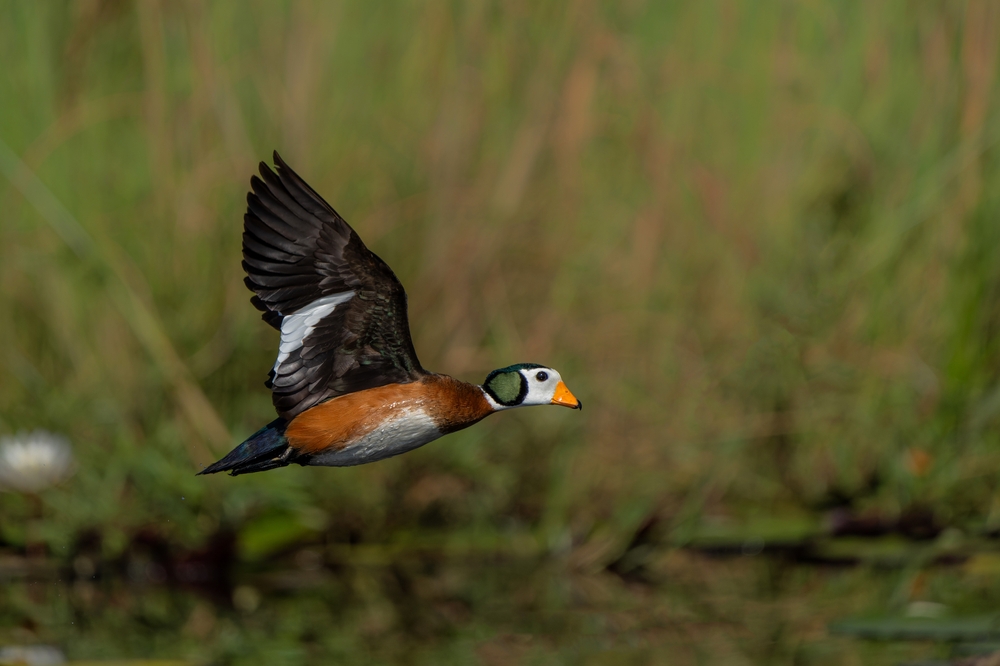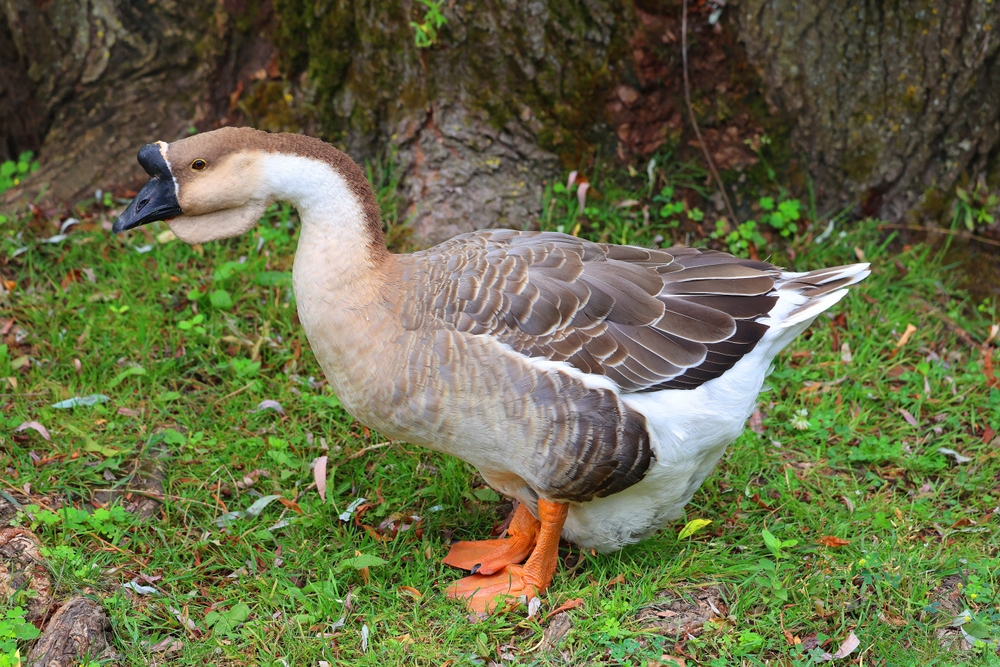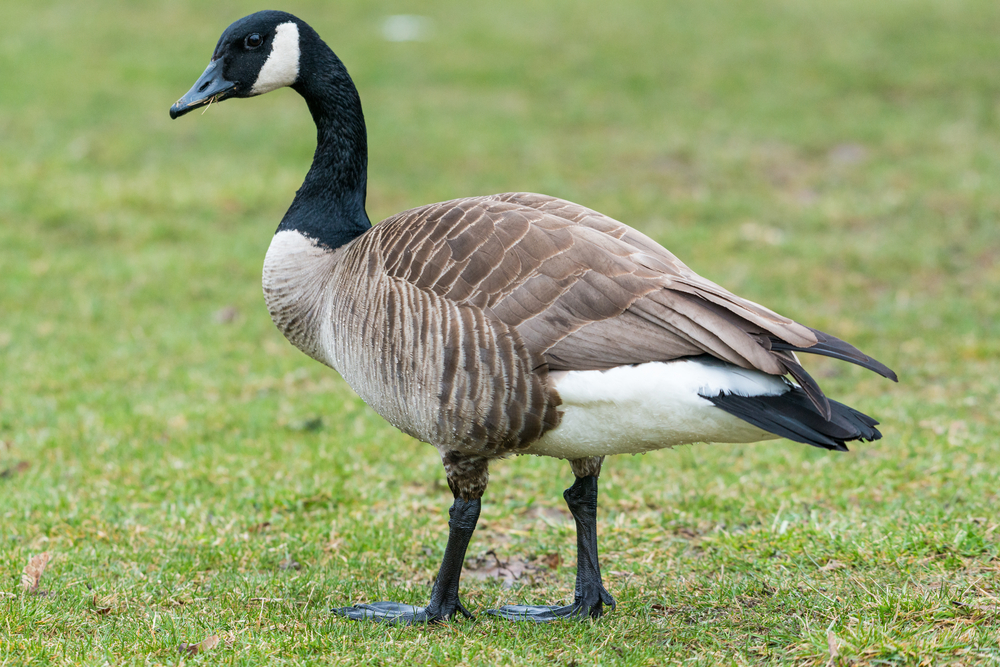Its closest relatives are other Nettapus species, particularly the Cotton Pygmy Goose (Nettapus coromandelianus) of Asia and the Green Pygmy Goose (Nettapus pulchellus) of northern Australia. Together they form a small, unique group of perching ducks.
About
The African Pygmy Goose (Nettapus auritus) is a small and colorful waterfowl species belonging to the Anatidaefamily, which includes ducks, geese, and swans. Despite its name, it is more closely related to ducks than to true geese. Found widely across sub-Saharan Africa and Madagascar, this species prefers freshwater habitats such as lakes, ponds, marshes, and slow-moving rivers rich in aquatic vegetation.
Measuring only 27 to 30 centimeters (10.5 to 12 inches) in length and weighing around 260 grams (9 ounces), the African Pygmy Goose is among the smallest of all waterfowl. Its striking plumage makes it unmistakable: males have a glossy green back and crown, a white face with bold black markings, and a bright yellow bill, while females are more subdued with mottled brown tones and a duller bill. Both sexes have rounded wings and short tails, giving them a compact, delicate appearance.
These birds are primarily herbivorous, feeding on aquatic plants, seeds, and especially water lilies, which form the bulk of their diet. Their short, stubby bills are perfectly adapted for plucking vegetation from the water’s surface. They occasionally supplement their diet with small invertebrates.
Breeding occurs during the rainy season, when food and nesting sites are abundant. Unlike many waterfowl, African Pygmy Geese often nest in tree cavities near water, sometimes using abandoned holes made by woodpeckers or barbets. Clutches usually contain 6 to 12 eggs, and both parents contribute to raising the young.
The species is listed as Least Concern, as it remains widespread and relatively common, though it faces localized threats from wetland drainage, pollution, and disturbance. Its charming size, brilliant plumage, and unusual nesting habits make the African Pygmy Goose one of Africa’s most enchanting waterbirds.
Physical Characteristics
The African Pygmy Goose is one of the smallest waterfowl species in the world, celebrated for its striking plumage and compact size.
Plumage: Males in breeding plumage have a glossy green crown, nape, and hindneck, contrasting with white cheeks and a golden-yellow face. The breast and flanks are chestnut, while the back and wings are dark with an iridescent green sheen. Females are duller, with a gray-brown crown, white face marked with a dark eye stripe, and more subdued underparts. Both sexes show white wing patches visible in flight.
Head & Bill: The head is rounded and short-necked, giving it a dove-like appearance. The bill is short, broad, and yellow in males (gray in females), perfectly suited for grazing on aquatic plants.
Body & Wings: The body is compact and rounded, with short wings adapted for fast, direct flight. Despite their small size, they are strong fliers and agile swimmers, often seen darting among water lilies.
Size:
-
Length (Body and Tail): 10–12 in (25–30 cm)
-
Wingspan: 16–17 in (40–43 cm)
-
Tail Length: 2–3 in (5–7 cm)
Weight:
-
Adult Male and Female: 8–10 oz (230–280 g)
The African Pygmy Goose’s jewel-like plumage, tiny size, and preference for floating vegetation like water lilies make it one of the most distinctive and beautiful of Africa’s waterfowl species.
Reproduction
The African Pygmy Goose follows a breeding cycle closely tied to water levels, as it depends on flooded habitats and aquatic vegetation for nesting and feeding.
1. Mating and Courtship:
Pairs are monogamous and remain bonded through the breeding season. Courtship displays include synchronized swimming, head-bobbing, and soft whistling calls by the male.
2. Breeding Season:
Breeding usually coincides with the rainy season (varies regionally across Africa), when wetlands expand and food sources such as water lilies are most abundant.
3. Nesting:
They nest in tree cavities near water, often using abandoned woodpecker or barbet holes. Some pairs also nest in old weaver or swallow nests. Nest sites are lined with down plucked by the female.
4. Egg Laying and Incubation:
The female lays 6–12 eggs, white and smooth-shelled. She incubates them for about 24–27 days, while the male remains nearby to defend the territory.
5. Hatching and Chick Development:
Chicks are precocial (born with down and open eyes). Within a day of hatching, they leave the cavity and follow their parents to water. Both parents care for them, guiding them to food-rich patches of aquatic plants.
6. Fledging:
Young fledge at about 45 days but may remain with their parents for a short period after, gradually becoming independent.
7. Sexual Maturity:
African Pygmy Geese reach breeding age by about 1 year, enabling quick recruitment into the breeding population.
The species’ reliance on tree cavities for nesting makes the African Pygmy Goose vulnerable to the loss of mature trees near wetlands, though its broad distribution helps sustain populations.
Lifespan
The African Pygmy Goose is a small but hardy waterfowl, with its longevity shaped by wetland conditions, predation, and availability of nesting sites.
Lifespan in the Wild:
In natural conditions, African Pygmy Geese typically live 8–12 years. Many chicks do not survive their first year due to predation from raptors, snakes, and monitor lizards, but adults that secure territories and breeding sites can live over a decade.
Lifespan in Captivity:
In aviaries or managed care, where they are protected from predators and provided with stable food sources, individuals may live up to 15 years, though this is less common.
Threats to the African Pygmy Goose:
-
Habitat Loss: Wetland drainage, deforestation of cavity-bearing trees, and agricultural expansion reduce critical breeding and feeding areas.
-
Predation: Raptors, snakes, crocodiles, and mammals prey on both eggs and adults.
-
Human Disturbance: Hunting, egg collection, and disturbance of wetlands affect survival.
-
Climate Variability: Changes in rainfall patterns and prolonged droughts reduce breeding success and available habitats.
Conservation Status:
The African Pygmy Goose is listed as a species of Least Concern by the IUCN, thanks to its wide distribution across sub-Saharan Africa. However, local populations may decline where wetlands and mature nesting trees are lost.
Eating Habits
The African Pygmy Goose is a specialist feeder, with a diet closely tied to aquatic vegetation in African wetlands.
Diet:
Its primary food source is seeds and parts of water lilies (Nymphaea spp.), especially the fleshy seeds and bulbs. It also consumes other aquatic plants, small seeds, and occasionally aquatic insects or snails.
Foraging Strategy:
These geese forage mainly by dabbling and surface feeding, delicately picking seeds and plant parts from floating vegetation. They rarely dive, relying instead on their small size and agility to maneuver among lily pads.
Feeding Behavior:
They often feed in pairs or small family groups, though larger flocks may form in wetlands with abundant water lilies. Their short, broad bills are adapted for grasping and husking seeds.
Crop Feeding:
Like other waterfowl, they can store food in their crop for digestion later or for feeding chicks through regurgitation.
Seasonal Feeding:
Their diet shifts with seasonal flooding—feeding heavily on water lilies during high water, and on grasses and smaller aquatic plants as wetlands shrink during dry periods.
Ecological Role:
By consuming and dispersing water lily seeds, they play a key role in maintaining aquatic plant diversity and wetland health.
The African Pygmy Goose’s dependence on water lilies for food makes it a unique and specialized feeder among ducks and geese, tightly linked to Africa’s wetland ecosystems.
Uniqueness
The African Pygmy Goose is one of the most distinctive waterfowl species in the world, notable for its size, appearance, and lifestyle:
World’s Smallest Goose: Despite its name, the African Pygmy Goose is actually a small perching duck and is considered the smallest waterfowl species in Africa, and among the smallest globally.
Brilliant Plumage: Breeding males are striking, with glossy green crowns, golden-yellow faces, chestnut flanks, and white cheeks—making them one of Africa’s most colorful waterfowl.
Specialized Diet: Unlike most ducks and geese, it specializes in feeding on water lily seeds and bulbs, making it a highly adapted wetland specialist.
Cavity Nesting: While most ducks nest on the ground, this species nests in tree cavities, often reusing woodpecker or barbet holes. This unusual behavior links it more closely with perching ducks than with true geese.
Strong Fliers: Despite their tiny size, African Pygmy Geese are fast and direct fliers, with short wings that allow them to dart quickly between wetlands and vegetation patches.
Cultural Significance: In parts of Africa, their dazzling plumage has made them a familiar and admired bird, often mentioned in local traditions as symbols of wetland abundance.
Wide Distribution but Sensitive: Found across much of sub-Saharan Africa, their dependence on wetlands and mature cavity-bearing trees makes them highly vulnerable to habitat loss.
The African Pygmy Goose’s jewel-like appearance, unique nesting habits, and lily-pad lifestyle make it one of the most remarkable and specialized waterfowl species of Africa.
Be the First to Share Photos of This Species.
FAQ’s
1. What is the closest species to the African Pygmy Goose?
2. How does the African Pygmy Goose compare to other geese and ducks?
It is much smaller than true geese, weighing only 8–10 oz (230–280 g). Unlike grazing geese that forage on land, the African Pygmy Goose is highly specialized for wetlands, feeding almost exclusively on water lilies and nesting in tree cavities, a rare trait among ducks.
3. What national parks provide the best opportunities to see an African Pygmy Goose?
What national parks provide the best opportunities to see an African Pygmy Goose?
-
Okavango Delta (Moremi Game Reserve), Botswana – One of the best strongholds, especially in lily-covered lagoons.
-
Chobe National Park, Botswana – Common in floodplains and oxbow lakes.
-
Kafue National Park, Zambia – Seen along rivers and wetlands dotted with lilies.
-
Kruger National Park, South Africa – Occasionally observed in quieter pools and dams.
-
Bwabwata and Nkasa Rupara National Parks, Namibia – Good sightings in marshes and slow-flowing channels.





































































